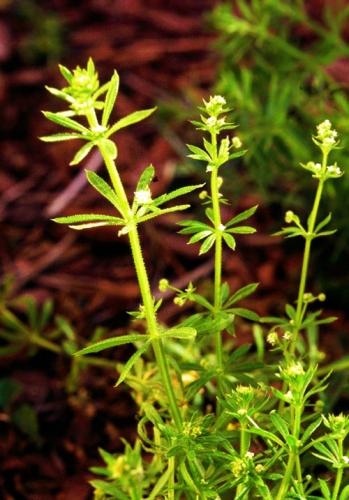Bedstraw is stuck on you
The annual weed bedstraw has made its presence known across Michigan gardens.
Every spring, some obnoxious or annoying weed becomes a big pest in many yards and gardens. Andy Warhol’s statement made long ago could also be applied to weeds: “They all get their 15 minutes of fame.” Some magic confluence of temperatures and rainfall has favored it over all the other weeds residing in many yards.
For many gardeners, this spring has brought an invader that seems supercharged and has popped up in many garden beds and areas that are not managed. It has many common names such as bedstraw, cleavers, catchweed bedstraw, sticky-weed or sticky-willie, to name just a few. Its botanical name is Galium aparine. If you have ever fought with it, you will remember it, even it you didn’t know its name.
Bedstraw grows rapidly in the spring and has long, weak stems and leaves that cling to everything like Velcro. Bedstraw climbs haphazardly over all of the surrounding plants, creating a sticky tangle of vines. Both the leaves and the stems have fine hairs tipped with tiny hooks. Because of its rapid growth, it can shade out smaller plants in a short time. When bedstraw grows in the sun, the prickly hairs are more robust than on shaded plants and can be more irritating to those pulling it out. The irritation is similar to being sandpapered. If you are sensitive to this scratchy plant, wear long sleeves and gloves when removing it.

Bedstraw. Photo credit: Ted Bodner, plants.usda.gov
Bedstraw produces small, white flowers followed by many small fruit that contain two seeds each. The round, green fruit and seeds are also prickly cling-tights. It is very easy for people or animals to pick up a load of hitchhiking seeds and transport them to a new area. The leaf layout is distinctive. The six to eight narrow, green leaves are arranged in whorls around the stem.
Because bedstraw gallops over and around all surrounding plants, there is no herbicide that can be used safely. The only option is the gardener’s usual “seek and destroy” of pulling and bagging it up. Luckily, it is shallowly rooted. The only good part is that the prickly plants can be shaped into a ball and lobbed out of the bed. If bedstraw is composted, the seeds will survive. It may be necessary to put it in a black, plastic bag, add a little water and lay the closed bag in the sun with the intention of steaming the seeds into submission.
Keep in mind that bedstraw can grow in the late spring and fall, too. So be on the lookout for this grabby weed and pull it when it is small. And remember that next year, another weed will have its moment of fame.



 Print
Print Email
Email
